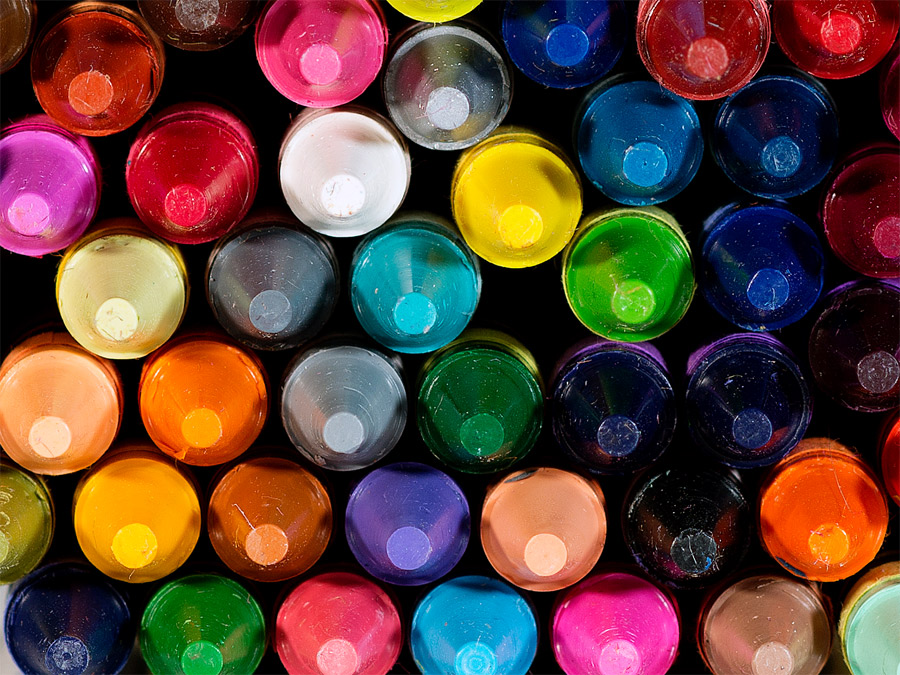I am working on a new two-dimensional variant of the Müller-Lyer illusion… You may be surprised to know that the Müller-Lyer illusion isn’t only linear: it involves plane geometry too! In fig. A shown below, the ends of the blue and red collinear segments, arranged in a radial fashion around a central point, delimit two perfectly concentric circles. However, for most observers, they seem instead to define a large ovoid that circumscribes another one, slightly eccentric (Fig. B). This comes from the fact that the red segments seem to stretch towards the lower part of the figure, while the blue segments seem to stretch towards the upper part of the same. As you can see, in this variant comes also into play the “neon color spreading” effect. In fact, a bluish inner oval-like shape appears within the black arrow heads (Fig. A), though the background is uniformly white.

Color
Illusive Op Art Skulls
I am currently working on new “neon color spreading” effects. Have a look at the pictures below… Though you perceive fluorescent grinning skulls, the vertical white stripes don’t contain any color at all, they are uniformly white! The trick lies on the fact that some black lines have very thin color edges. This illusory shading effect is also known as “subjective transparency” or “Tron effect”.
The neon color effect was first observed by D. Varin in 1971. The human ability to perceive a neon effect may be a remnant of the development of our power of sight under water at extreme depths, where light is very poor.
My Op Art Skulls are available as prints and t-shirts from my online store.
Emerson’s Secret
When Crayola‘s senior designer Emerson Moser retired in 1990—after 37 glorious years of loyal service—he finally confessed to a little secret: he was color vision deficient! Moser went on to produce a record 1.4 billion crayons during his career…
While any type of color vision deficiency (color blindness) could make crayon production difficult, complete color vision deficiency, where someone can only see in shades of gray, is extremely rare. About 99% of color vision deficiency involves just the inability to distinguish between some pairs of complementary colors.
So, if you’re wondering about your own color vision, feel free to take the test on my website.

What color does it look to you?
1 in 12 people have some sort of color blindness that makes them unable to distinguish certain colors or shades of colors from others. Color blindness is, however, an inaccurate term to describe a lack of perceptual sensitivity to certain colors; a more precise term is: Color Vision Deficiency (CVD). Color blindness is the most commonly used term though it is misleading if taken literally, because colorblind people CAN see colors, albeit they cannot make out the difference between some couples of complementary colors. Color vision deficiency is not related to visual acuity at all and is most commonly due to an inherited condition. Red/Green color vision deficiency is by far the most common form, about 99%, and causes problems in distinguishing reds and greens. There is no treatment for color vision deficiency, nor is it usually the cause of any significant disability.
The most commonly used test to detect color vision deficiencies is the Ishihara Color Test.
Color vision deficient people have a tendency to better night vision and, in some situations, they can perceive variations in luminosity that color-sighted people could not. In fact, most color blind people can easily read what is written in the dotted pattern below… If you fail the test, that means you probably have the full range of color sensitivity that is attributed to color-sighted people.
[Highlight the blank space to see the answer: NO]

Different but Equal
It happens sometimes to read on a snack the following notice: “with chocolate taste”, written in uppercase. This statement tricks our mind! In fact, the vast majority of us think that such a snack MUST contain chocolate, no one thought however that a flavor is not a substance and most probably the snack we bit into contains only an ‘illusion’ of chocolate.
The same occurs with colors, our brain is easily tricked by them. Colors are just like ‘flavors’, they may smell, pardon… look like a specific color, but they are just an illusory subjective sensation, not an ‘external’ reality. Colors undoubtedly change depending on their surrounding or the context in which they are viewed. More mind-blowing still is the fact that colors that are identical may appear to be different under certain conditions, and colors that are different may look the same. Such a curious effect is called “color induction”. Continue Reading

